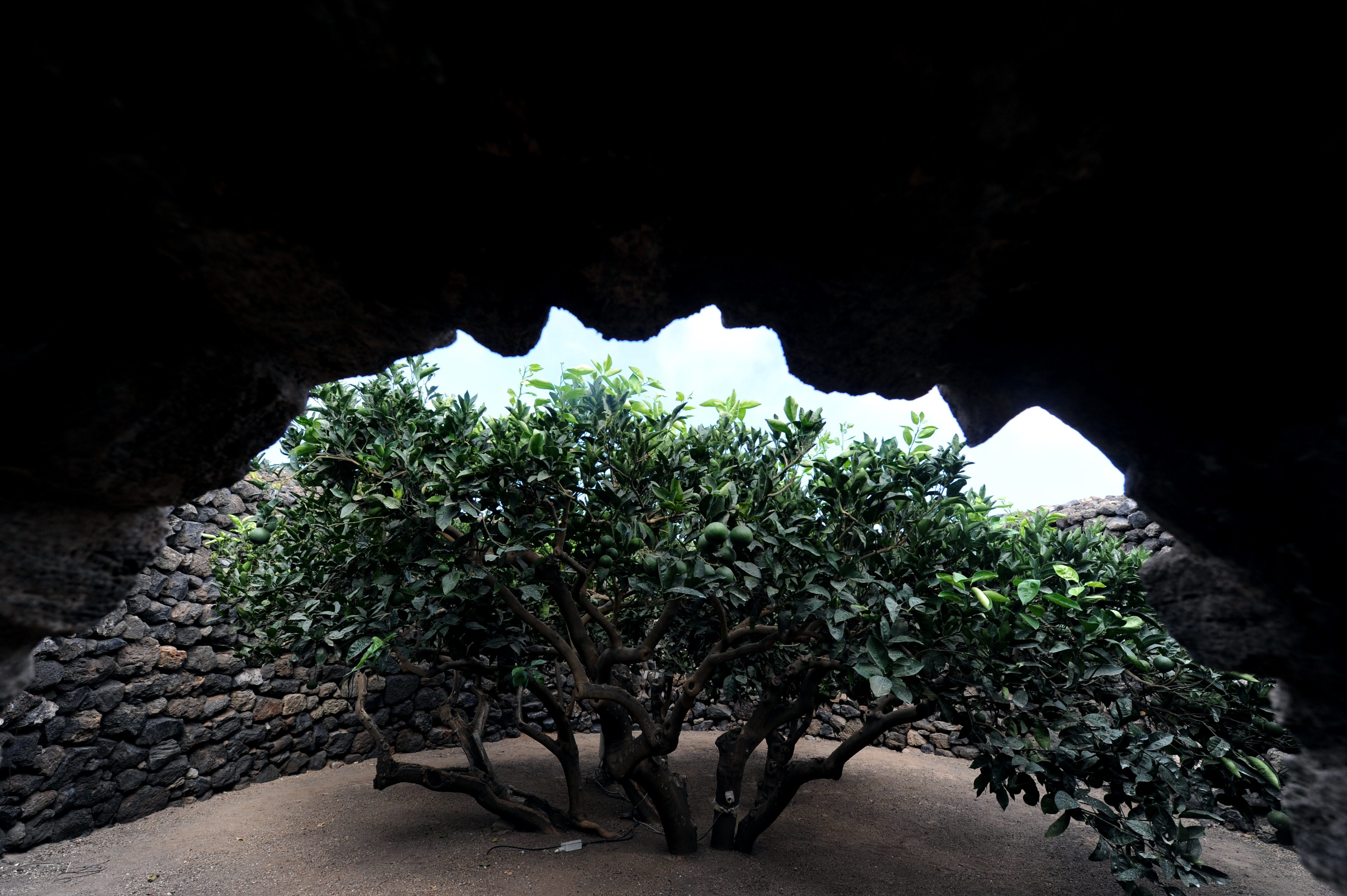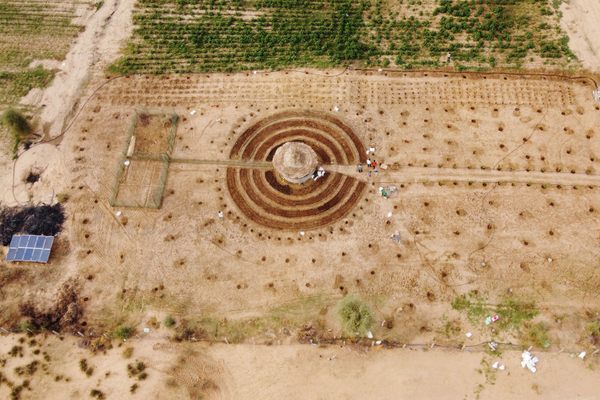The Ancient Walled Gardens Designed to Nurture a Single Citrus Tree
Giardini Panteschi are found only on the windswept island of Pantelleria.

A windswept speck of land in the Mediterranean boasts a unique innovation found nowhere else on earth: a circular garden wall that creates its own nano-climate. But this invention isn’t new: It dates back over a thousand years.
The remote Italian island of Pantelleria is so far from the rest of Italy that it’s actually closer to Africa. On a clear day, you can even see the coast of Tunisia from the island’s lofty volcanic peak.
Pantelleria has a hypnotic beauty that entrances the few travelers who reach its shores: Ancient mule tracks wend through patchwork vineyards dotted with crumbling ruins, while passing cars are so rare that hard-working farmers wave at every one. In all directions, wherever you look, the denim-blue sea sparkles.
The main challenge faced by Pantelleria’s 7,000 inhabitants, aside from the isolation that sequesters them from the outside world, is the weather: The island is constantly battered by winds, but rarely sees any rain. The soil is dry and full of volcanic rock.
How to eke out a living in such a place? For thousands of years, different groups have done so during different periods. But at some much-debated point, Pantellerians devised an ingenious garden design now known as the giardino Pantesco: Italian for “Pantellerian garden.” What makes these enclosures extraordinary is that each giardino Pantesco was built, with months of backbreaking labor, not to nourish rows of vegetables, but instead to protect a single sprout: the sapling of a lone lemon or orange tree.

“Of all agricultural systems, no other architecture involves so much work to grow a single tree,” notes Giuseppe Barbera, Professor of Arboriculture at the University of Palermo and one of the world’s few experts on Pantellerian gardens.
“The enclosed tree is a citrus—usually an orange or a lemon—that otherwise couldn’t grow on the island without the protecting wall,” Barbera adds. “Pantelleria’s windy, arid climate and the total absence of fresh groundwater wouldn’t otherwise allow trees like these to live.”
Giardini Panteschi are almost always circular, and are precisely calibrated to have walls of a specific height: tall enough to block the wind, but short enough to allow in as much sun as possible. For as long as anyone can remember, farmers have expertly employed an age-old construction technique called muro a secco. Without using any mortar, they stack basketball-sized boulders freehand to form five-foot-thick walls that curve to encircle an enclosure 30 feet in diameter. They leave a single small opening through which the builder can crawl.
“The Pantescan farmer tore the stones from the ground with his bare hands, and used them to construct garden walls,” says local vintner and retired politician Calogero Mannino.

The top of the circular wall always slopes inward, so the crevices of the volcanic rock catch morning dew and atmospheric condensation, which then drips onto the soil—even on otherwise dry days.
At the center of all this, the farmer plants just one seed in hopes of eventually growing a full-size citrus tree, which he then allows to branch outward in all directions and fill the whole space with several trunks (unlike the more familiar practice in modern citrus orchards of pruning away all side-shoots to produce a tree with a single central trunk).
The end result of all this labor is a new ecosystem within the wall’s embrace, where the tree experiences temperatures measurably cooler on hot days and warmer on cold nights, an effect confirmed by ongoing studies. “The research has shown the importance of dew condensation on the garden walls, which reaches considerable quantities because of the atmospheric humidity and the porosity of the rocks that increases the surface area,” says Barbera, who is monitoring climatic data being collected at the best-preserved giardino. “This contribution of water is so important that it allows citruses to be cultivated in the total absence of irrigation.”
Giardini Panteschi have been described as self-sufficient agronomic systems, because they create a nano-climate that simultaneously waters the tree, protects it from relentless wind, retains any rainwater channeled into the garden under the access door during rare rainstorms, allows in sunlight, and radiates stored solar warmth on cold nights. Once built, it “operates” without any need for further human intervention.
Pantellerians were pioneers in sustainability before there was even a word for it. They did not get stones from some far-off quarry, but instead used rocks dug from the enclosed garden area itself. As Pantelleria sits atop a dormant volcano, the terrain comprises basically nothing but fractured volcanic rock, without much topsoil. Every square inch of vineyard and farmland on the island had to be hand-cleared of countless stones; on the island, people joke and conjecture that the garden walls probably evolved as the answer to the conundrum, What do we do with all these rocks we just dug up?

A giardino Pantesco—also known as a “jardinu” in local dialect—is only one component of a traditional Pantellerian homestead, each element of which has an immediately recognizable vernacular architecture. At the center is the dammuso, or living quarters, with massively thick walls and a distinctive domed roof. The unforgettable, undulating shape is also unique to Pantelleria, and designed to collect rainwater and channel it down to a subterranean cisterna. A hardened pathway from the dammuso downhill to the jardinu also serves as a rainwater conduit, funneling runoff under the small garden gate. Farmers thresh grain in a nearby aira (another perfectly circular area but with lower walls) and sun-dry grapes and figs in the stinnituri, a south-facing wall with angled buttresses.
All these architectural features developed to deal with the constant hot winds known as sirocco that blow in from the Sahara and the Levante winds that blow in from the Near East. These winds dominate Pantelleria’s weather as many as 300 days per year.
No one knows for certain who built the first giardino Pantesco: Some attribute it to the Phoenicians, who colonized the island 3,000 years ago. Others cite the Greeks, the Romans, the Crusaders, the Ottomans, or one of the many other civilizations that occupied Pantelleria over the millennia. Most often credit is given to the Arabic-speaking settlers who invaded in 700 A.D. and stayed for centuries; many of the island place names—such as Gadir and Bugeber, which belong to an ancient Arabic dialect similar to Maltese—date to this period.
“The surviving gardens were mostly built between the 18th and 19th centuries,” Barbera points out, “but it is probable that they have been present on the island since ancient times.”
Despite the relatively arid climate and chronic shortage of fresh water, the slopes of Pantelleria now appear surprisingly verdant. Vineyards dot the island, a situation made possible because the local grape variety, Zibibbo di Pantelleria, has evolved to survive with minimal irrigation. The centuries-old technique for keeping grape vines alive on Pantelleria—extensive pruning so that they hug the ground, behind yet more hand-built stone walls—is the only farming practice UNESCO deems “An Intangible Cultural Heritage of Humanity.”

About 400 giardini Panteschi survive today, in various states of disrepair. Of these, 300 are precisely circular, while others are rectangular, pentagonal, or even teardrop-shaped due to the nearby terrain.
Whatever its shape, there’s something almost mystical about entering a jardinu, as if you’re entering a temple to the tree itself. The space inside feels set apart from the real world outside. “One enters them bowing, the shade and the coolness immediately felt, the imposing walls giving the feeling of entering a sacred place,” Barbera ruminates.
Why citrus, and not some other tree? As far back as the Middle Ages, it was known that fresh fruit, especially citrus, prevented scurvy. Giardini Panteschi may have provided the only source of vitamin C on the island.
The only giardino Pantesco officially open to the public is managed by the Fondo Ambiente Italiano in the vineyards of the Donnafugata winery near the village of Khamma. But some of the dammusi rented to vacationers have their own giardini, and any leisurely drive around the island will reveal a few of the unmistakable circular walls (but always ask permission before entering).
Famed architectural philosopher Bernard Rudofsky visited Pantelleria and became fascinated by the unique design of its gardens, marveling about them in his book The Prodigious Builders. “The Pantellerian giardino represents an unheard-of extravaganza,” he writes. “It embodies the archetype of ‘paradise’ (originally a Persian word meaning ‘circular enclosure’), complete with the tree of sour knowledge.”
Gastro Obscura covers the world’s most wondrous food and drink.
Sign up for our email, delivered twice a week.









































Follow us on Twitter to get the latest on the world's hidden wonders.
Like us on Facebook to get the latest on the world's hidden wonders.
Follow us on Twitter Like us on Facebook